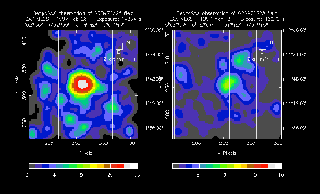GRB 970228 X-ray counterpart: Left panel: Eight hours after the detection of GRB 970228, BeppoSax was able to isolate an X-ray source at the location of the GRB. Right panel: Three days later, the source had faded, showing that it was a transient source, very likely associated with the GRB. This is the first X-ray counterpart data captured following a gamma-ray burst.
Credit: BeppoSAX Science Data Center (SDC) and the Agenzia Spaziale Italiana (ASI)
You see, what we do is look for these bursts first in the gamma-ray part of the spectrum, where there might be one or two a day; we try to establish the direction, and then we look in other wavelengths to try to identify a counterpart. But after 10 years of investigation with Compton, we still needed to identify counterparts in the optical wavelength. The way BATSE located gamma-ray bursts wasn't very accurate. Its error box was large and the ground-based observatories would not spend their precious observing time trying to cover the entire region of the error box. Nobody was very much interested in looking for the optical counterparts except us.
And we didn't know what was the critical point in time. How quickly did we have to look after seeing the gamma-ray burst? Did we have to do it fast, or would the source still be visible for days afterward? And then how bright would the optical counterpart be? And how would the brightness decay? Did we need a big telescope or a small telescope that was fast enough?
So up until this point scientists were examining data to find the properties of GRBs and were getting nowhere. The big question was what was the origin of these gamma-ray bursts—galactic or cosmological—and, depending on where it was, what could create something like that? This changed with the launch of the Italian-Dutch satellite BeppoSAX in 1997. BeppoSAX had an instrument, the Wide Field Camera, that could locate GRBs very accurately compared to BATSE. On February 28, 1997, BeppoSAX spotted a GRB astronomers would name GRB 970228, referring to the year (1997), month (February), and day of the month (28) of the discovery. Not only did it catch the burst, BeppoSAX also discovered the first X-ray counterpart of a gamma-ray burst.


